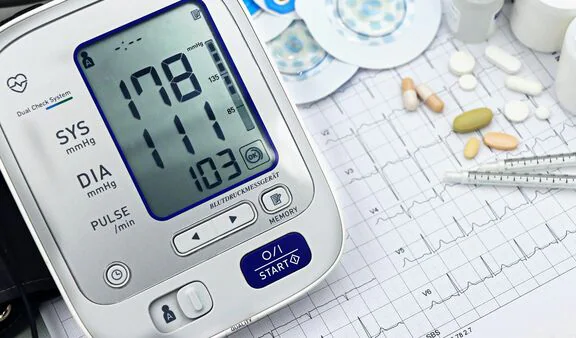
How to manage high blood pressure with simple lifestyle tweaks
How did your country report this? Share your view in the comments.
Diverging Reports Breakdown
How to manage high blood pressure with simple lifestyle tweaks
World celebrated Hypertension Day on May 17. A May 2024 WHO report states that Indians have been consuming nearly twice the recommended amount of sodium (10.98 gms) This is making the population more susceptible to high blood pressure (hypertension) WHO’s recommendation is to use Lower Sodium Salt Substitutes (LSSS) Unavoidable as hypertension or blood pressure is, Lounge spoke to experts to know if there are simple tweaks you could make to your daily to control this condition. According to Dr Anuja Agarwala, parents should be aware that hypertension can exist in children too. If not managed well, hypertension can lead to serious health issues, such as heart disease, stroke and kidney disease, cautions Dr Jamuna Prakash, former professor, food science and nutrition, Mysuru University of University of Mysore. The most common symptoms of hypertension are sleep deprivation, an inability to focus and fluctuation in energy levels. More serious symptoms could include blacking out and being on the verge of collapsing.
“While the risk of developing hypertension increases as one ages, recent research has revealed alarming statistics about its prevalence among Indian adolescents, with rates as high as 25 per cent. That’s why it’s important for people with a family history of diabetes and hypertension to start getting regular BP checks in their mid-20s. Others can wait until their early 30s to start testing for hypertension,” says Dr Anuja Agarwala, vice president, Indian Dietetic Association, Delhi. According to Agarwala, parents should be aware that hypertension can exist in children too. So, if high blood pressure and cardiovascular diseases run in the family, schedule regular BP checks for your children too.
SYMPTOMS
“About a decade back, hypertension would happen to those in their 50s. These days, due to high stress, lifestyle, genetic factors and addictions, people are getting hypertension at even 28. And the risk is higher if you’re obese,” notes Dr Swarup Swaraj Pal, head of cardiovascular and thoracic surgery at Gleneagles Hospital, Mumbai. Pal explains that hypertension happens when calcium gets deposited in the lining of the blood vessels, causing it to harden. This adds pressure to the heart as it’s pumping harder. If left unattended, this can eventually result in cardiovascular disease.
The most common symptoms of hypertension, according to Pal, are sleep deprivation, an inability to focus, throbbing headaches and fluctuation in energy levels. More serious symptoms could include blacking out and being on the verge of collapsing. “Get your blood pressure checked every three-six months, especially if you’re above 30,” he advises, and reiterates that the risk of one being affected by hypertension is high if you have parents who are obese or have a history of heart disease. “While women are more or less protected by the hormone estrogen till age 45 or 50, after menopause, they too are at a risk of suffering from hypertension,” Pal adds.
Hypertension, Agarwala says, manifests in symptoms as small as headaches. “What makes it particularly dangerous is that it does not cause specific symptoms until it’s too late. If not managed well, hypertension can lead to serious health issues, such as heart disease, stroke and kidney disease,” she cautions.
Also read: Why short bursts of cold showers are good for you
WAYS TO MANAGE HYPERTENSION
Apart from medication, Agarwala’s top tips for managing hypertension naturally include quitting drinking and smoking; getting adequate sleep for about eight hours; reducing exposure to stressful environments– if your work environment is stressful, step out every four hours or so; and exercise three-four times a week. She cannot stress enough about the importance of physical exercises. “It is important to make time for it at least 3-4 times a week. But those who are unable to dedicate time for exercise should try and include more walking into their daily routine. Walking 10,000 steps a day is considered beneficial for your cardiovascular health.”
It’s also crucial to be aware of how sodium insidiously adds up in your diet. It might be the chutney you eat at lunch or those rice crackers you have at tea. According to Agarwala, including fruits and vegetables in your diet is another effective way to maintain healthy blood pressure.
GET CREATIVE WITH INGREDIENTS
Mysuru-based Dr. Jamuna Prakash, former professor, food science and nutrition, University of Mysore, says, managing hypertension isn’t about entirely cutting out namkeens us Indians are so fond of from our diet, but consuming it judiciously. “Whilst cooking, pairing salt with low-sodium seasonings like MSG (monosodium glutamate), along with an assortment of herbs and spices, can bring out an ideal balance of umami, saltiness, and other traditional Indian flavors—making for a satisfying meal without the need for additional sodium,” she says.
Adding smokiness to your paneer and chicken preparations can provide additional complexity to the flavor profile of the dish, says Mumbai-based chef Ajay Chopra. “Borrowing from culinary practices around the world, like using kombu or seaweed broth, as done in Japan, can create umami in certain soups and curries. Adding lemon juice is another way to add flavour to your dishes, and stimulate your taste buds,” he notes.
Sumitra Nair is an independent journalist based in Kochi.
